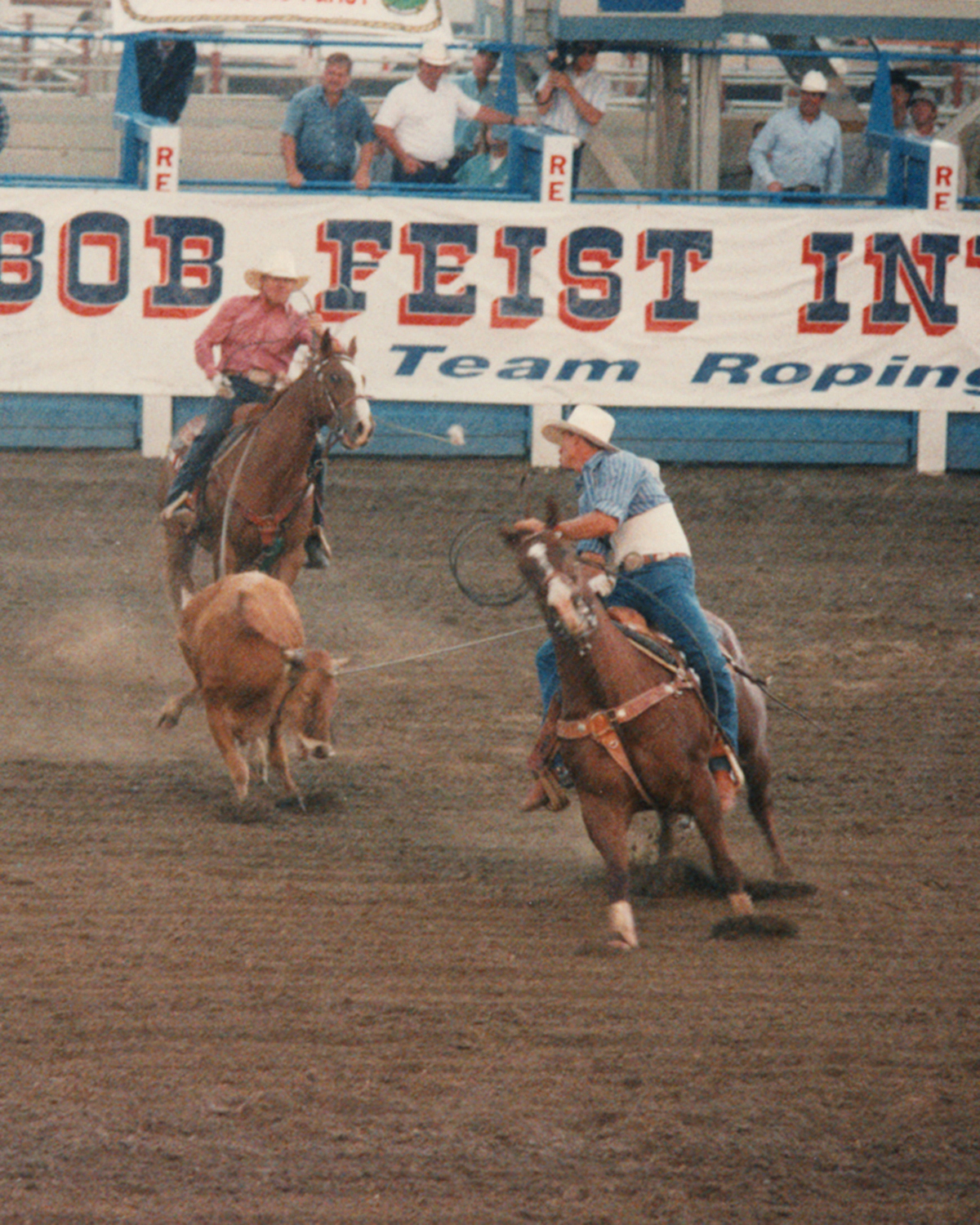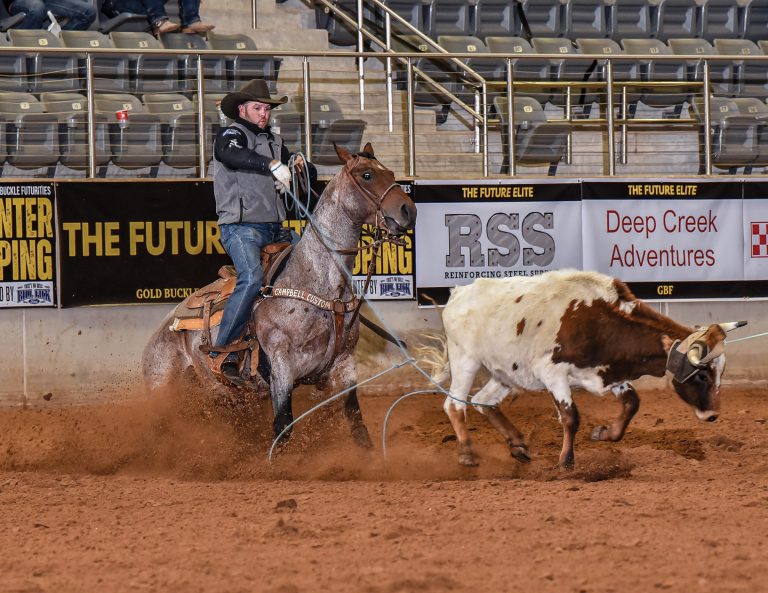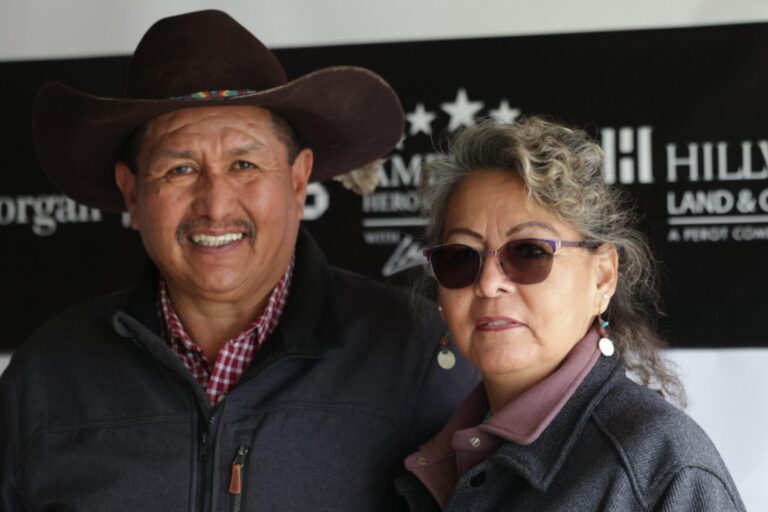
The first horse that put me on the map was a solid bay by the name of Bullwinkle. Richard Carpenter got him from Arnie Mayer up in Montana, and I first saw Bullwinkle when Richard came to the winter rodeos with Dennis Tryan. They were staying in Chandler, Arizona, and Richard was heading on Bullwinkle at the rodeos. I got to see the horse go, and could tell he was incredibly fast—bulldogging-horse fast. Richard let me take Bullwinkle to Tucson, we won something and I bought him.
Bullwinkle was a very difficult horse. He scored like a bulldogging horse, so the biggest challenge was just trying to get him out of the barrier. He was kind of sully in the box, and Bullwinkle broke a lot of tie-down straps.
[READ MORE: Traits of a Winner with Jake Barnes]
Bullwinkle was about 15 hands tall, 1,200 pounds and so strong. The cattle were big and strong back then. Back in the Cotton Rosser days, we’re talking 600-pound elephants with big horns that were sometimes bulldogged one year and team-roped the next.
I got Bullwinkle the year I roped with Leo (Camarillo), in I think 1984. He was strong enough to get ahold of those big steers, and it was just incredible how fast he could run. Drawing the pup wasn’t the best-case scenario for that horse. I was actually better off on Bullwinkle when a steer broke and ran.
I rode Bullwinkle for several years, and he was really good at the NFR. He was so fast across the line, and was so strong up that left wall at the Thomas & Mack. I could just reach, and stick it on ’em. He didn’t score very good, but most of our scores were hip or tail to the pin.
[READ MORE: How These 5 Common Rope-Horse Conformation Attributes Affect Soundness]
Bullwinkle was not a very good jackpot horse, because if you made very many runs on him, he’d get hot in the box and it was kind of a train wreck. I’d get mad at him, and at times even tried to sell him. But nobody wanted any part of him, because he was like a two-headed snake. And thinking about selling Bullwinkle was stupid on my part, because I won so much on him.
The next good horse I rode was Big John. I got him the year we won the BFI, in 1988. Big John was a bigger, 15.2-hand chestnut sorrel, and he did everything good. He scored, and could really run. He wasn’t a ducker. Big John was a run-to-the-hip, handle steers, face-good horse.
Big John was really good, but unfortunately didn’t last very long. He had a freak accident out in the pasture, stuck something in the front of his ankle and got an infection. He got over that, and I rode him again. But he never did really come back to what he was before.
After Big John, I struggled for years not having much for horses. Then I got Peppy Doc from (steer wrestler) Terry Thompson, and he was almost like a carbon copy of Big John. I won Cheyenne with Walt Woodard on Peppy Doc. He probably would have been my best horse, if he’d had top-end speed.
When I was roping with Boogie Ray (in 2003), I came across Barney. I’d say Barney was my best horse overall, because he was good at rodeos and jackpots. I bought Barney from Squeaky Terrell in East Texas.
[WATCH: Fine-Tuning Aggressive, Green Horses on Roping.com]
I started roping with Boogie at Reno in June that year, and told him I’d enter as long as we were winning. I ran out of horsepower by about Dodge City in August. Then Barney’s name came up. Squeaky was Boogie’s neighbor, so he called and asked if he’d lease Barney. He said yes, we went to Dodge City the next morning and won the round.
With Barney on the team, we went to winning. It was the craziest thing you’ve ever seen. That horse changed everything. It was like going from driving a Volkswagen to a Corvette, and we won $20,000 almost instantly. You couldn’t pull on Barney in the box or he’d come off the ground. He was automatic out in the field. Barney had a big knee, but I bought him and he stayed sound for quite a while.
In the end, it’s the horses that define your career. They have mine. Like the old saying says, “An old cowboy never dies, he just gets a new horse.” TRJ











